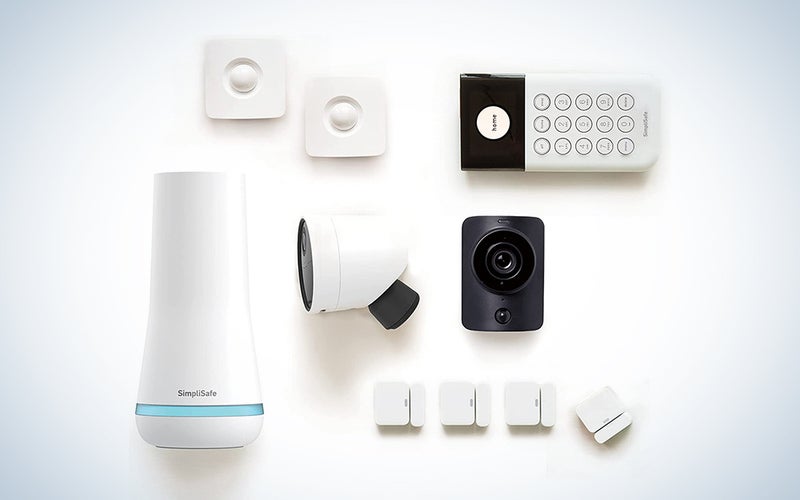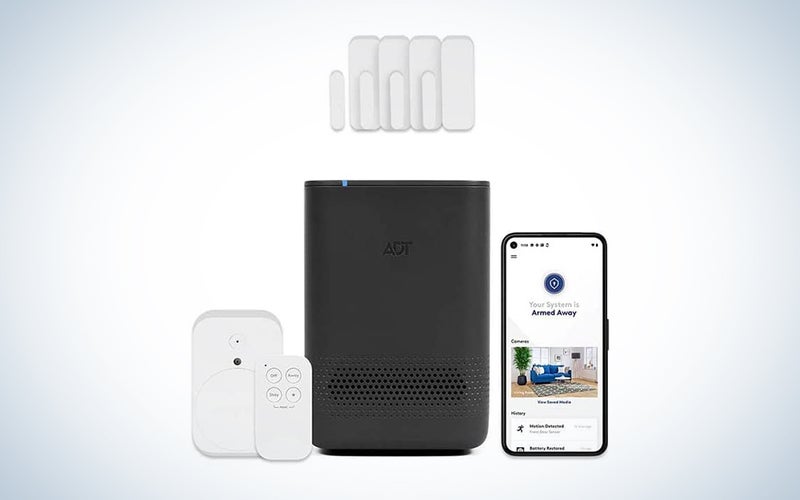We may earn revenue from the products available on this page and participate in affiliate programs. Learn more ›
If you’re worried about crime impacting your household, it makes perfect sense to buy one of the many smart home security systems that have popped up over the past few years. However, with abundance comes analysis paralysis. To what system should the savvy, safety-conscious consumer turn? We investigated the market to bring you the best smart home security systems so you can pick the best choice for your living situation and loved ones.
How we chose the best smart home security systems
While nearly every product you buy enters your home at some point, there is something particularly intimate about inviting in a smart home security system. Unlike shoes—something that only needs to function well enough when called upon—your smart home security system needs to function perfectly 24/7/365. That’s why one of the bigger ranking factors this time was brand satisfaction. Cybersecurity and data protection were other key factors because, while less is often more, in the world of security more really is more. You’re only as strong as your weakest entry point.
This guide was compiled after many hours of careful research; facts and opinions were cross-examined by editors. Ordinary users were asked about their experiences using these devices, and we interacted with customer service agents throughout the course of compiling this guide. Each company’s personal website and plan information were thoroughly checked for the most up-to-date service plan information possible.
The best smart home security systems: Reviews & Recommendations
Our selection of smart home security systems comes from a wide variety of well-known and trusted brands with a broad array of attached services. While kits differ, they all typically include sensors for your doors and/or windows and an alerting mechanism. One of our picks is sure to match your budget and lifestyle.
Why it made the cut: The SimpliSafe 10-Piece system is a very complete kit that starts the security before your door is opened.
Specs
- Installation difficulty: Easy
- Sensors: 4 door/window sensors, 2 motion sensors, 1 indoor camera, 1 outdoor camera
- 24/7 professional monitoring: $28/mo. (Optional)
- Smart protocols: N/A, but Alexa- and Nest-compatible
Pros
- Outdoor cam so your security starts before an intruder enters your home
- Comes with one free month of 24/7 professional monitoring service
- The variety of parts gives you a more complete sense of security
- Optics and branding
Cons
- Must learn to set up each part correctly
If you’re looking for a system that is essentially complete directly out of the box, the SimpliSafe 10-Piece Wireless Home Security System is the kit for you. It includes a variety of sensors and indoor and outdoor cameras, meaning you should feel fully protected in your home. While each piece is easy to install in and of itself, you’ll have to learn and think about the placement of each part—however, you’ll be able to handle it on your own if you can handle a strip of 3M tape or a screwdriver. Let’s review each part individually to get a good picture of how they will function together in your home:
The SimpliSafe base can hold up to 100 SimpliSafe security devices and is the central hub for your equipment. It is also capable of emitting a 95dB alarm. The push-button keypad lets you arm and disarm the system with a PIN. Having four entry point door/window sensors will allow you to protect the primary entryways to your home, while the two motion sensors—which are designed to be pet friendly and decorative—protect the areas of your home with too many entry points or windows.
What makes the SimpliSafe 10-piece system better than the 12-piece version is the inclusion of both an indoor and an outdoor camera. Suppose you’re used to the grainy, near-worthless security cam footage often seen in local news coverage. In that case, you’ll be particularly happy with the full colors, 1080p quality, and night vision offered by SimpliSafe. For those concerned with privacy, the indoor camera comes with a stainless steel shutter, so you won’t have to worry about having your private moments enter someone’s data tables.
Finally, the package set comes with an official SimpliSafe flag that declares your home protected by SimpliSafe. While no one can guarantee that this will deter all criminals, there will be at least a few that will back down.
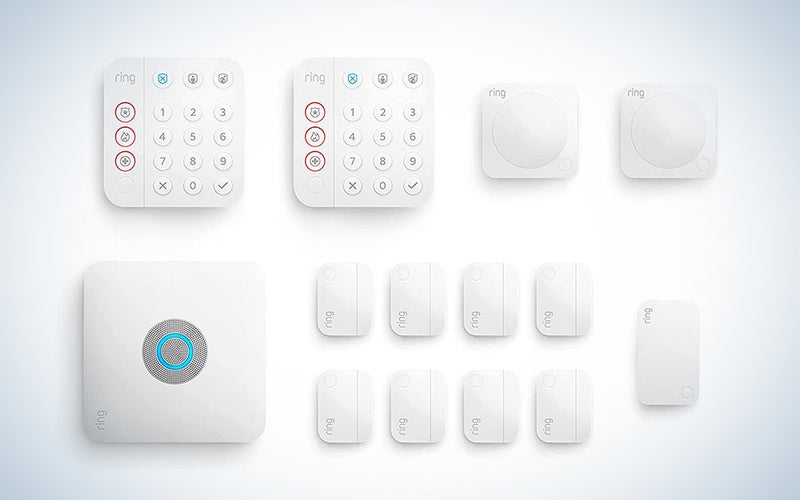
Why it made the cut: Go from dialing a number to “Hello” in 1 minute, 18 seconds.
Specs
- Installation difficulty: Easy
- Sensors: 8 door/window sensors, 2 motion sensors
- 24/7 professional monitoring: Between $4-$20/mo. (Optional)
- Smart protocols: Z-wave
Pros
- Fantastic phone technical support
- Dual keypads for increased flexibility
- Provides range extender for large homes
- Multiple 24/7 monitoring plans to choose from
Cons
- Overhyped WiFi functionality
The Ring Alarm Pro 14-Piece set has fantastic customer service and is a great smart home security system for larger homes. Its impressive networking and dual keypad design (some home security systems only allow for one keypad) allow for larger coverage areas than some of the best smart home security systems. With customizable ringtones, you’ll always know which door is being opened in your home. The Ring Alarm Pro even comes with Wi-Fi 6 functionality via its hub. This feature is handy but gets a bit overhyped, sometimes eclipsing what counts—there are better Wi-Fi 6 routers out there.
What should you get excited about with the Ring Alarm Pro? A very approachable DIY setup where a real human is there to help you quickly. After just a few button taps to specify exactly what we wanted, we could—right here, right now—contact a customer service agent 1 minute and 18 seconds after dialing Ring’s customer service.
Why it made the cut: ADT is amongst the most experienced and best professional monitoring companies.
Specs
- Installation difficulty: Intermediate
- Sensors: 4 door/window sensors, 1 motion detector
- 24/7 professional monitoring: $19.99/mo. (Optional)
- Smart protocols: Z-wave
Pros
- Highly experienced monitoring team
- Perfect size for families
- Optics and branding
Cons
- Occasional installation snags
- Only works in the U.S.
The ADT 8-Piece Wireless Home Security System is all you need to get started with the highly regarded ADT security model. It’s a brand that takes itself seriously, providing a yard sign to let customers proudly display their security status on the lawn. Sure, it is part marketing, but it’s also part confidence in the ADT name alone being able to ward off potential neighborhood thieves.
The package itself includes door/window sensors and a motion sensor, with the kit being targeted to owners of two- or three-bedroom homes. While not difficult, installing the sensors can take some time as you manually pair and label each one within your system. You can install them using the included adhesive backing or a more traditional screw-in technique. The time investment should feel closer to “weekend project” than “plug’n’play” for the typical first-time user.
When combined with the optional professional monitoring from ADT, it can almost feel as if you have a dedicated housesitter while you’re away.
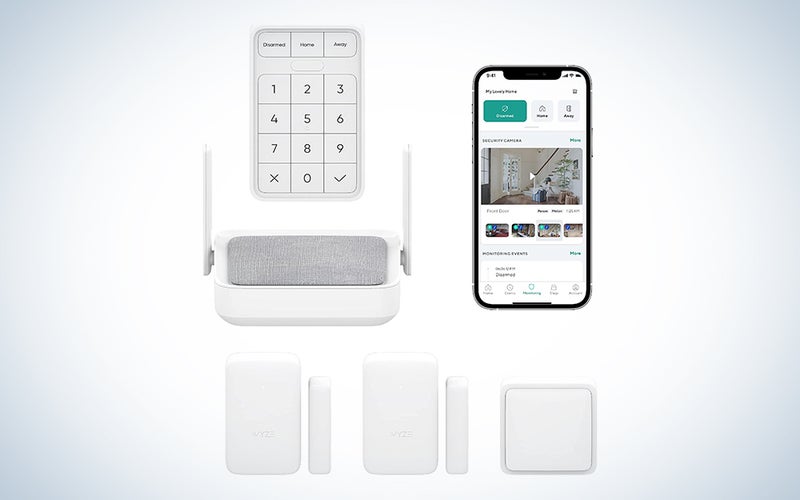
Why it made the cut: Wyze’s Home Security Core Kit is just that, a quality core kit that can be easily added to as needed.
Specs
- Installation difficulty: Easy
- Sensors: 2 door/window sensors, 1 motion sensor
- 24/7 professional monitoring: $9.99/mo
- Smart protocols: N/A
Pros
- Very affordable and complete starter kit
- Comes with three months of free professional monitoring
- Can easily add on more sensors or cameras
- Guided setup via Wyze app
Cons
- Service plan essential
- Only works in U.S.
If you prefer to wade through new technology instead of diving directly into the deep end, the Wyze Home Security Core Kit will be the best smart home security system for you. For starters, the core kit itself is very affordable, covers two entry points plus a room of your choice, and provides months of complimentary professional monitoring service to give you a taste of how Wyze works.
Once you’ve decided how much you like the system, you can start adding more components immediately. Finish off the rest of your home’s entry points with more door/window sensors, or transform your setup into a video surveillance system by adding a Wyze cam. Leak and home climate sensors are also available.
The modularity, as well as the stick-on setup guided by the Wyze app, gives the Wyze Home Security Core Kit a very DIY air to it. You can be confident that you, by yourself, should be able to install it. Unfortunately, the rugged individualism this inspires is dropped down a notch—it requires a 24/7 monitoring subscription for the device to truly shine. You’ll just have sensors, but the keypad won’t work after the three-month free trial runs out. The Wyze Cam add-on will also lose smart features and extended storage. Still, the service is cheaper than market averages, you probably wanted it anyway.
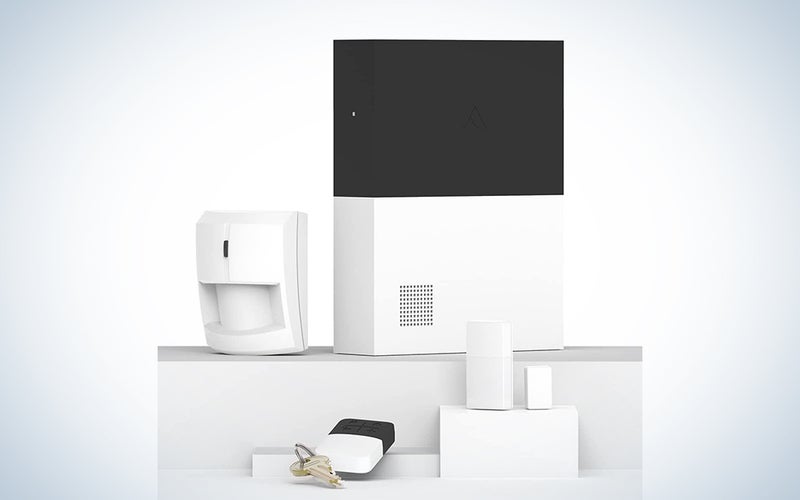
Why it made the cut: Abode goes way beyond just Z-wave and Zigbee.
Specs
- Installation difficulty: Easy
- Sensors: 1 door/window sensor, 1 motion sensor
- 24/7 professional monitoring: Between $7-$22/mo. (Semi-optional)
- Smart protocols: Zigbee, Z-wave, Homekit, IFTTT
Pros
- Connects and works with just about anything
- Variable professional monitoring options
- Sub-30-minute total setup time
- Easily expandable
Cons
- Limited sensors in starter kit
- Reviews note poor customer service
Can’t decide between Zigbee and Z-wave, so want access to both? Not sure if you want to use Alexa or opt for a Google home security system? Need HomeKit or IFTTT support? It’s time to look at an Abode Security System, a home security system that connects with all of these in some way.
The Abode Security System Starter Kit is a perfect way to get set up with the system, as it includes the main hub, a couple of sensors, and a key fob. You’ll find it surprisingly easy to set up and get going—even technological turtles report installation times of under 30 minutes—but will quickly find yourself wanting other pieces if you don’t have, for example, home security cameras from an existing, compatible system. If you decide to stick with Abode products, you can choose from glass break sensors, water leak sensors, smoke alarms, and indoor/outdoor cameras to tailor the system to your needs.
While all owners have access to alerts and live video feeds, more “advanced” features—such as video storage—require you to subscribe to one of Abode’s plans, either the Standard (self-monitoring) or Pro (professional monitoring).
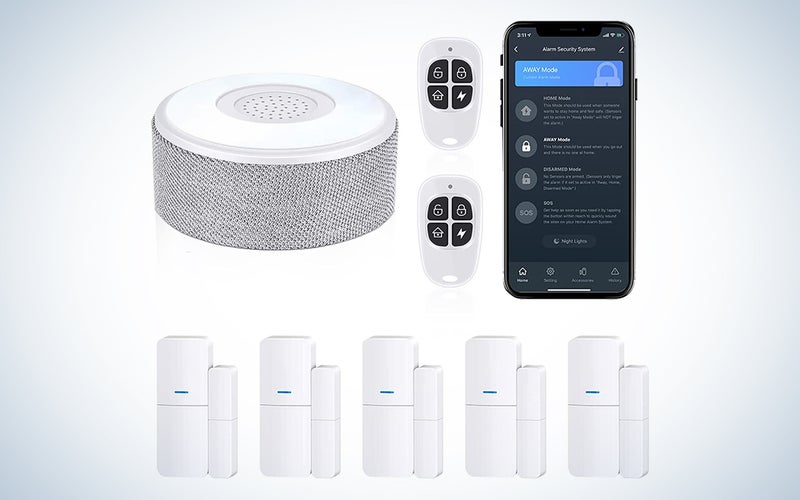
Why it made the cut: This is the best smart home security system under $100.
Specs
- Installation difficulty: Easy
- Sensors: 5 door/window sensors
- 24/7 professional monitoring: No
- Smart protocols: N/A
Pros
- Simple to use system with keychain fob and app control
- Very loud alarm
- Affordable for all pricing
- No monthly payments
Cons
- Supported by 2.4GHz Wi-Fi network only
- Lower brand recognition
If you’re wanting to avoid overly techy solutions to your problems and save money in the long run while doing so, the Tolviviov Wi-Fi Door Alarm System is worth checking out. Tolviviov systems, in addition to being budget-friendly, also happen to be the best smart home security systems for elderly people due to their extremely loud alarm systems and manual keychain controls. It still has app functionality, including Alexa support, for those wanting a more modern feel.
Considering the price range, it shouldn’t be surprising that the Tolviviov system doesn’t have a professional monitoring system. However, this lack comes with a silver lining, as systems with professional monitoring on a recurring monthly subscription often tie other features into it. With the Tolviviov, what you see is what you get. A loud siren to alert you to entries, app alerts that tell you what sensor was disturbed, and the option for Alexa voice support. It’s simple, but it works.
The main concerns for the Tolviviov system are its connections and brand recognition. The Tolviviov only works with the 2.4GHz Wi-Fi band. Be prepared to isolate the 2.4GHz band. Lastly, the brand recognition just isn’t there yet. Sure, the super loud alarm will make burglars scram, but you won’t get the same response from the name “Tolviviov” that you will from an “ADT” sign in your yard or a Ring video doorbell near your front door.
What to consider when buying the best smart home security systems
From the surface, the best smart home security systems appear to be quite similar, just different collections of the same parts. This is compounded by the fact that, when things are running smoothly, our residential security systems blend into the background of our lives. However, if you do even a tiny amount of digging, you’ll see that there is more complexity in both the hardware and the included customer service plans than meets the eye.
Options for 24/7 professional monitoring
If you have a smart home security system that alerts you when intruders come into your home, or when your house faces other problems, you are all in the clear, right? While it is a nice thought, it is potentially untrue if you are incapacitated or unable to reach your phone to assess the threat (such as while out at work or on vacation).
Typically, 24/7 professional monitoring services come as part of a subscription fee, usually around $30 per month. While all systems retain some functionality without the subscription, others only provide limited service without the full subscription.
Zigbee and/or Z-wave connection
Much like Wi-Fi, Zigbee and Z-Wave represent frequency bands that can connect the pieces of your smart home security system together. Zigbee systems typically run faster, but burn through batteries quicker, while Z-Wave systems can have a bit of response delay but require less battery maintenance work.
In reality, which of the two systems is better depends on your overall network. If you have a lot of Z-Wave products already, going with another Z-Wave device is great because they are all mandated to work together. Zigbee devices can usually “find” each other but don’t always interconnect in a fully functioning way, sorta like pairing non-Apple headphones to your iPhone via Bluetooth.
Another possibility includes using neither system and operating solely through Wi-Fi and the system’s own proprietary hub. If you are looking for a smart home security system and not a full smart home network, this should be fine. Alternatively, super-compatible systems can connect to both networks and have other connection options as well. Whether you want to go with Zigbee or Z-Wave or both is entirely up to you.
Branding and flags
Some smart home security systems have a flag to stick in your lawn to scare potential thieves away. Some customers are happy to see it, but others are skeptical about the usefulness of a sign to deter thieves, who might use the info to “crack” through the system.
What does the science say? Our friends at Bob Vila took a deep dive into the research on security signs and crime deterrence. Here are some of their findings:
- ~25% of criminals will skip a home with a security sign.
- ~50% of criminals will skip a home with a security sign and a visible camera.
- The optimal locations for such signs are in a place visible from the street and in the backyard.
- Branding matters. A recognizable or easily searched-for brand name works best to convince thieves your home is really protected.
Privacy
Whenever you bring something into your home, you want to feel comfortable about your privacy. This goes doubly so for home security products that can record and monitor the inside of your home. As such, you should pay particular attention to a brand’s privacy track record.
Take, for instance, the recent controversy over Anker’s eufy brand, which promised end-to-end encryption but didn’t deliver. If that wasn’t damaging enough, the company’s initial response was to merely change their privacy commitment statement. They’ve since come clean, but the sour taste still lingers.
For full transparency, this is not the only brand to have publicly suffered a privacy breach. In 2021, a former ADT technician pleaded guilty to charges of criminal spying while employed at the company. Important things to note here are how well ADT handled the situation compared to eufy, that their internal procedures and systems have since been changed to reduce the likelihood of a similar situation happening in the future, and that this was an incident involving a single employee and not the company at large. The ADT system in this guide does not include a camera.
FAQs
Q: How much does a smart home security system cost?
A smart home security system can cost anywhere from under $80 to over $400. You should also leave room in your budget for a monitoring subscription, which typically costs between $20 and $40. Overall, smart home security systems are highly affordable and shouldn’t outprice other smart gear for your home.
Q: What is the highest-rated home security system?
The highest-rated home security systems come from SimpliSafe and Ring. With new products and bundles being released regularly, as well as shifting prices, consumer ratings for individual bundles may fluctuate over time. That being said, highly regarded product bundles from both companies can receive a coveted 4.7 stars or higher on Amazon after hundreds (or even thousands) of reviews.
Q: Is smart home security worth it?
Smart home security is worth it if you are nervous about the safety of your home or neighborhood. Some systems can check for flooding and fires as well. With 24/7 professional monitoring, you also have access to a team that is ready to help you and alert authorities in case of an emergency. People wanting smaller, less extensive security should consider smart doorbells as a potential alternative.
Q: Is SimpliSafe better than Wyze?
It depends on what you want in a system. SimpliSafe is among the highest-rated smart home security systems, and the SimpliSafe 10-Piece Wireless Home Security System is our personal pick for the best smart home security system due to its high-quality performance and complete coverage. This isn’t to say that Wyze systems are bad, as the Wyze Home Security Core Kit is a premium choice for those that want a custom, modular system.
Final thoughts on the best smart home security systems
Getting one of the best smart home security systems in 2023 is not as difficult as in years past. Installation should be smoother due to the simplicity of wireless Zigbee, Z-Wave, and Wi-Fi connections that can integrate these systems with the existing smart home gadgets you already own. With app integration and voice support, you can get the truly convenient home security you desire.
Why trust us
Popular Science started writing about technology more than 150 years ago. There was no such thing as “gadget writing” when we published our first issue in 1872, but if there was, our mission to demystify the world of innovation for everyday readers means we would have been all over it. Here in the present, PopSci is fully committed to helping readers navigate the increasingly intimidating array of devices on the market right now.
Our writers and editors have combined decades of experience covering and reviewing consumer electronics. We each have our own obsessive specialties—from high-end audio to video games to cameras and beyond—but when we’re reviewing devices outside of our immediate wheelhouses, we do our best to seek out trustworthy voices and opinions to help guide people to the very best recommendations. We know we don’t know everything, but we’re excited to live through the analysis paralysis that internet shopping can spur so readers don’t have to.






